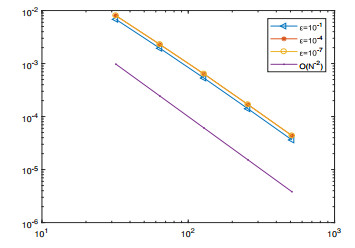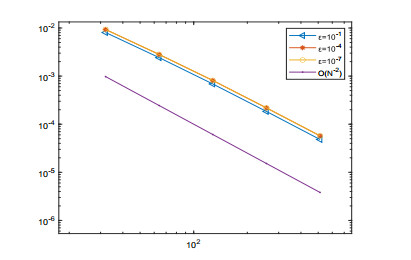1.
Introduction
Volterra integro-differential equations (VIDEs) with a first-order derivative term arise from population growth models, biology, medicine, physics, and so on [1,2,3]. When the first-order derivative of such problems is multiplied by a perturbation parameter ε, these problems are called singularly perturbed Volterra integro-differential equations (SPVIDEs), which are given by
where 0<ε≪1 is a perturbation parameter and functions a(x), f(x), K(x,t) are sufficiently smooth. In additional, we assume that there exists a positive constant β such that a(x)≥β>0. Under these conditions, Eq (1.1) has a unique solution [4]. Furthermore, the derivatives of u(x) have following bounds (see [4, Lemma 1.1])
where C is a positive constant, which is independent of ε. Obviously, it can be seen from Eq (1.2) that the exact solution u(x) of Eq (1.1) exists a exponential boundary layer at x=0 as ε→0. It is well known that SPVIDEs are widely used to describe a nonlocal reaction-diffusion model in spatially inhomogeneous media that takes into account feedback and nonlocal interactions [5].
Due to the presence of perturbation parameter ε, some traditional finite difference and finite element methods on a uniform mesh could not obtain reliable numerical results. Therefore, the layer-adaptive grid (Bakhvalov and Shishkin meshes) and adaptive grid methods are widely used to construct some parameter-uniform numerical methods for solving SPVIDEs, see [6,7,8,9,10,11,12] and references therein. Among these existing methods, the accuracy of most of these methods is only first-order. For this reason, many researchers studied some second-order accurate numerical methods for Eq (1.1). For example, the authors in [13] used the Richardson extrapolation technique to improve the ε-uniform convergence of the adaptive grid method from first-order to second-order. Yapman [14] designed a homogeneous (nonhybrid) type difference scheme on Shishkin-type mesh for Eq (1.1), and confirmed that the numerical method was almost second-order convergent.
It is well known that the variable two-step backward differential formula (BDF2) technique has widely used to approximate the time derivative with second-order accurate for linear parabolic equations and differential-algebraic problems [15,16,17]. In particular, in [17], the authors introduced discrete orthogonal convolution kernels for the first time and utilized them to prove the stability and convergent of the adaptive BDF2 time-stepping scheme in L2 norm. Recently, the authors [18] applied the BDF2 technique on a Shishkin mesh to solve the problem in Eq (1.1) and proved that the proposed method was almost second-order uniformly convergent. In addition, the result in [19] suggests that the BDF2 all-at-once system utilizing the preconditioned Krylov subspace solvers can be a competitive solution method for Riesz fractional diffusion equations.
Inspired by the BDF2 that we recently used in [18], where we designed a novel finite difference scheme to prove ε-uniform convergence for a Shishkin mesh. In this paper, we prove ε-uniform convergence of this finite difference scheme on a Bakhvalov-type (B-type) mesh. The advantage of this paper is that the convergence rate of our numerical method do not contain lnN-factors, where N is the number of mesh steps.
The paper is organized as follows: The construction and characteristics of Bakhvalov-type mesh is introduced in Section 2. This is followed by the stability analysis of the discretization scheme in Section 3. Then the bound of truncation error and the parameter-uniform convergence of the numerical method are proved in Section 4. In Section 5, the statement of the numerical experiment illustrates that our theoretical findings are effective. Finally, some concluding discussions are presented in Section 6.
To simplify the notation we set gi=g(xi) for any function g and set Ki,k=K(xi,xk). The maximum norm denoted by ‖K‖:=max(x,t)∈Ω2|K(x,t)| and ‖g‖:=maxx∈Ω|g(x)|. In addition, for any sequences {γk} if the index j>i, we assume the summation i∑k=jγk=0 and i∏k=jγk=1.
2.
The Bakhvalov-type mesh
Let ˉΩN:={0=x0<x1<…<xN=1} be a B-type mesh with the local mesh step size hi=xi−xi−1, i=1,2,…,N. Then, for ti=i/N, the B-type mesh points xi can be obtained by the following generating function [20,21]
where φ(t)=−ln[1−2(1−ε)t], J=N/2 and μ is a positive mesh-parameter that satisfy μβ≥2. For the sake of simplicity, ri=hi/hi−1(i=2,…,N) represents the i-th step-size ratios.
Next, the next two lemmas list some characteristics of the above B-type mesh.
Lemma 2.1. The step sizes of the B-type mesh defined by Eq (2.1) satisfy
Proof. The proof of Eqs (2.2)–(2.4) can be found in [22, Lemma 1]. Here, we just need to prove Eq (2.5). In fact, by using Eqs (2.1) and (2.2), one has
where ξi∈[ti−1,ti], i=2,⋯,J−1, which completes the proof.
Lemma 2.2. Let {xi}Ni=0 be the B-type mesh generated by Eq (2.1). Then we have
Proof. The proof can be found in [23,24].
3.
Discretization scheme and stability analysis
Before constructing a second-order discretization scheme for Eq (1.1), we first give the definition of two-step backward differential formula as follows: For a given function g, let Pi,kg be the corresponding Lagrange interpolating polynomial over points xi,xi−1,…,xi−k. Then the first-order derivative of this polynomial at point x=xi can be obtained by
where b10:=1/h1, bi0:=1+2rihi(1+ri),bi1:=−r2ihi(1+ri) and bij:=0 for 2≤j≤i−1,i≥2. Therefore, by using Eq (3.1) and the trapezoidal formula to approximate the first-order derivative and the integral term, respectively, we obtain the following discretization scheme
where uNi is the approximation solution of u(x) at point x=xi.
To facilitate the analysis of the stability and convergence of the discretization scheme in Eq (3.2), we first define a discrete orthogonal convolution (DOC) kernels {θii−j}ij=1, which is given by (see [17, Lemma 2.3])
Then by using the following discrete orthogonal identity
where δik is the Kronecker delta symbol, we obtain
Furthermore, the next lemma list a characteristics of DOC kernels:
Lemma 3.1. [17, Corollary 2.1] The DOC kernels θii−j has following property
Now, based on the above definition of DOC kernels in Eq (3.3) and the proof of Lemma 2 in [18], we list the stability of the above discretization scheme in Eq (3.2).
Lemma 3.2. Under the condition that there exists a constant α∗ such that
the solution uNi of Eq (3.2) satisfies
Proof. For i=1,⋯,N, multiplying both sides of Eq (3.2) by the DOC kernels θii−j, and summing j from 1 to i, we get
Then, combining with Eq (3.5), yields,
Based on Eq (3.7), we have
where we have applied the fact that
Then, from Eqs (3.8), (3.9), it is easy to obtain
Furthermore, we have
where
Obviously, to derive the bound for |uNi|, we only need to estimate the bounds of Ij, j=1,2,3, respectively. For I1, it follows from Lemma 3.1 that
where we have interchanged the order of summation. Similar to Eq (3.12), we get
From Eqs (3.11)–(3.13), we obtain
where the sequences {λk} are defined by
Finally, by using the Grönwall inequality, see [25, Lemma 3.2], one has
which completes the proof.
In order to derive convergence analysis below, we also give the bound of |uNi| for i=1,⋯,J−1 as follows:
Lemma 3.3. For i=1,⋯,J−1, we have
Proof. Firstly, for i=1, it follows from Eq (3.2) that
Then, by using Eq (2.3), yields,
In addition, set ηi=εhi1+2ri1+ri+ai+hiKi,i2, by using the Eq (2.5), we have ηi≥C(ε/hi+α∗). Furthermore, similarly to Eq (3.11), one has
where the sequences {λk} are defined by
Using the Grönwall inequality, we get
The result of this lemma can be implied by Eqs (3.16), (3.17).
4.
Convergence analysis
Let eNi:=ui−uNi, i=1,2,3,…,N, denote the error at point x=xi in the numerical solution. Then we have
where
Lemma 4.1. Under the B-type mesh defined in Eq (2.1), we obtain the following estimations
and
Proof. We first consider the truncation error |R1,i| when i=1, by using Taylor's expansion formula, Eq (1.2), Lemma 2.1 and Lemma 2.2, we have
For 2≤i≤J−1 and i≥J+2, the step-size ratios 1≤ri≤3, then for the reason of Eq (4.7), we can obtain
where we have used fact that
for any positive monotonically decreasing function ϕ on [c,d], see [26].
Furthermore, for i=J,J+1, the truncation error R1,i can also be estimated in the following form:
Now, we need to estimate the second term on the right-hand side of Eq (4.9) to obtain a estimate of |R1,i|fori=J,J+1. Firstly, for i=J+1, one has
Secondly, for i=J, if ε≤N−1, by using Eq (2.4) it is easy to get that
On the other hand, if ε>N−1, we can get that
From Eqs (4.8)–(4.12), we get |R1,i|≤CN−2 for 2≤i≤N.
Different from BDF2, the discretization of the integral part in Eq (3.2) does not require two starting points, we can estimate R2,i for 1≤i≤N.
which completes the proof.
Finally, we can get the main result of this paper as follows:
Theorem 4.1. Let u(x) be the solution of Eq (1.1) and uNi be the solution of Eq (3.2) on the mesh ˉΩN. Then, under the condition β+hiKi,i2≥α∗>0, the error satisfy
Proof. From Eq (3.16), we have |eN1|≤CN−1|R1,1+R2,1|≤CN−2. In particular, Lemma 3.3 imply that
Next, for i≥J, it follows from Eq (3.3) and Eq (3.15) that
where Lemma 3.1 are used. This completes the proof.
5.
Numerical results and discussion
In this section, to confirm our theoretical results, we present numerical results for two test examples. As the exact solution of this test problem is available, the computed errors and rates of convergence are defined by
respectively, where uNi is the solution of the discretization scheme in Eq (3.2). Here, in all numerical experiments below, we choose ε=10−k,k=1,…,7 and N=2m,m=5,…,9. Meanwhile, to obtain the Bakhvalov mesh ˉΩN, we choose μ=2 for Example 1 and μ=23 for Example 2. All experiments were performed on a Windows 10(64 bit)PC-Intel(R) Core(TM) i7-7500U CPU 2.70GHz 8 GB of RAM using MATLAB R2017a.
Example 1. The first example is taken from [14]:
where
The exact solution is u(x)=1/(1+x)+e−x/ε. The numerical results of Example 1 are listed in Table 1.
Example 2. We consider the following singularly perturbed Volterra integro-differential equation:
Since the exact solution of this test problem is not available, we use the double-mesh principle [14] to calculate the maximum point-wise errors as follows:
where u2Ni is the solution of the Eq (3.2) on the following mesh:
For different values of ε and N, the numerical results of Example 2 are displayed in Table 2.
Tables 1–2 illustrate that the errors are robust with respect to ε, and the convergence order is close to 2. Meanwhile, Figures 1–2 display the log-log plot of these errors computed by our presented numerical method. In summary, our numerical results confirm our theoretical results.
6.
Conclusion
We have discussed the ε-uniform convergence of the variable two-step backward differentiation formula of a reduced linear singularly perturbed Volterra integro-differential equation on a Bakhvalov-type mesh. We first proved the stability of our discretization scheme. Then, the proof of ε-uniform convergence can be given by the stability of the numerical method.
Acknowledgments
This work is supported by the key project of the Natural Science Foundation of Guangxi Province (AD20238065), the Natural Science Foundation of Guangxi Province (2020GXNSFAA159010), and the National Science Foundation of China (12261062).
Conflict of interest
The authors declare there is no conflict of interest.









 DownLoad:
DownLoad:




